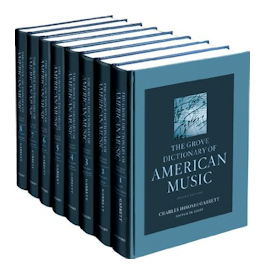
The Internet's Premier Classical Music Source
Related Links
-
Introduction
Acoustics
Ballet
Biographies
Chamber Music
Composers & Composition
Conducting
Criticism & Commentary
Discographies & CD Guides
Fiction
History
Humor
Illustrations & Photos
Instrumental
Lieder
Music Appreciation
Music Education
Music Industry
Music and the Mind
Opera
Orchestration
Reference Works
Scores
Thematic Indices
Theory & Analysis
Vocal Technique
Search Amazon
Recommended Links
Site News
 Book Review
Book Review
The Grove Dictionary of American Music

Second Edition
Charles Hiroshi Garrett, Editor in Chief
New York: Oxford University Press, 2013
Eight volumes. 5,592 pages. (two large columns a page.) 9,300 entries, 4,835 new.
447 images and 137 music examples.
ISBN-10: 019531428X
ISBN-13: 9780195314281
Updated massively from the four volumes of the 1986 New Grove Dictionary of American Music edited by H. Wiley Hitchcock and Stanley Sadie, this publication is a major publishing event.
Emphasis in the new work appears to be on popular music. There is a very long article on Gospel Music, and one on Hip Hop, including its globalization; among articles on localities, one on tourism said nothing about the major classical music destinations. The Ojai Festival in California rates an article, but it might well have been longer; the same is true of the artist colonies Yaddo and the MacDowell Colony. The long article about Cincinnati was quite unbalanced in this respect also. A brief article about Herman Melville mentioned some songs related to his great novel Billy Budd, but did not even mention Britten's opera based on it. There are entries for some historians of classical music: Joseph Horowitz, Joseph Machlis and Carol Oja, for instance. Other general topics include Feminism in American Musical Life, Intellectual Property and Copyright.
No one will have expected a reviewer to read everything in this huge work, so in view of the general focus of this reviewing site I selectively looked at articles about American classical composers of particular interest to me. Seeing how seriously some musicians are currently regarded in comparison with others based on the length of their entries seemed an interesting and reasonable thing to do. John Cage is given seventeen columns, including a seven column listing of his works. (Who would have thought so many?) Leonard Bernstein gets sixteen columns; so does Virgil Thomson, perhaps surprisingly; Randall Thompson has only two an a half, mostly on his academic career, including an observation that he is "largely dismissed in academic circles as an amateur's composer," in spite of the overwhelming popularity of his "Alleluia"; Elliott Carter has fifteen columns; Edward MacDowell has fourteen; Roy Harris has ten columns, Lou Harrison nine, and Alan Hovhaness seven, with five listing his works. Pauline 0liveros gets five. Lukas Foss is covered in four and a half, including a superficial coverage of his early neoclassical works, even though three authors are credited. Arthur Berger gets four columns; Walter Piston, a far better and more prolific composer gets about the same. Quincy Porter has two columns, Cole Porter seven and a half. Edward Burlingame Hill, admittedly obscure at present, has a little more than a single column, but significant points about his style and output are lacking. The article on Ingolf Dahl has good specifics on his style, as does one on Lopatnikoff and one on Louise Talma.
Copyright © 2014, R. James Tobin



















